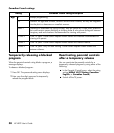
Finding Answers to Questions
Finding Answers to Questions 43
Finding Answers to Questions
Understanding TV Terms
What are analog TV, digital TV,
and high-definition TV (HDTV)?
Devices such as monitors, tuners, and integrated
monitor/tuner combinations are designed to handle
any of the 18 formats officially sanctioned by the
industry-led standard setting, Advanced Television
Systems Committee (ATSC), for the digital transmission
of video signals. There are three subgroups of digital
televisions depending on their capabilities: high-
definition (HDTV), enhanced-definition (EDTV), and
standard-definition (SDTV).
In contrast, U.S. analog television has been available
for over 50 years in the single National Television
Standards Committee (NTSC) format. This is the signal
format that has been broadcast over the air and
through cable systems. NTSC television offers slightly
more than 480 interlaced lines of resolution.
To view high-definition programming, your TV must
receive high-definition signals by means of a
high-definition signal source connected to the
television. The source can be an off-the-air high-
definition antenna or cable HD signal, or an HD
source, such as a cable or satellite provider HD set-top
box, an HD-DVD player, and so on. All sources except
an HD antenna or cable HD signal must connect to one
of the High Definition Input connector sets on the rear
of the TV. Your cable or satellite provider may require
additional purchase for high-definition programming;
off-the-air high-definition broadcasts may not be
available in all areas.
What is the difference between
progressive and interlaced
signal formats for digital TVs?
There are 18 standard digital TV signal formats. Each
provides a different picture quality. The names of these
digital TV formats consist of a number followed by
either p (progressive) or i (interlaced). The letter refers
to the way the TV uses the signals to create the picture:
■ Progressive (p) scanning presents all the
horizontal lines of the picture in one frame. This
provides a sharper picture to the eye, and looks
much better than an interlaced image of the same
resolution.
■ Interlaced (i) means that the picture appears in
two segments; every other horizontal line of the
picture is displayed in one frame, and the other
half of the horizontal lines are displayed in the
next frame. This works because it happens so fast
that the eye is deceived into believing that only
one picture is being shown.
The number in the names of the formats refers to the
number of lines of resolution. Generally speaking, the
higher the number, the better the picture. For example,
with digital TV (DTV), there are two progressive
formats for broadcasters to choose from: 480p and
720p. 480p has 480 horizontal scan lines. Although
the 480p image is much sharper than a regular TV
broadcast, it is considered only a DTV signal and not a
true high-definition signal. 720p has 720 horizontal
scan lines and is considered to be true HDTV. 720p
can rival a 1080i picture, in which 1080 horizontal
scan lines are displayed as an interlaced image. The
sharper and more accurate (progressive) 720p picture
looks better, even though a 1080i picture has many
more scan lines and a much higher resolution.


















